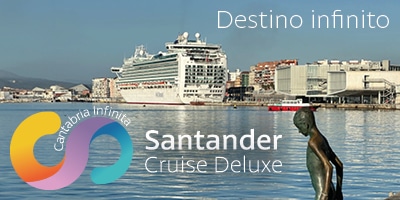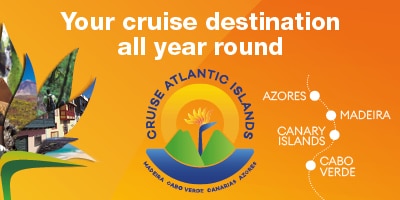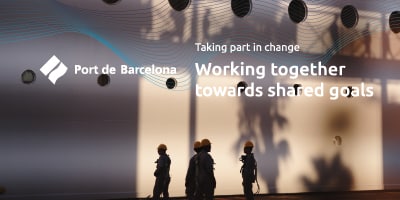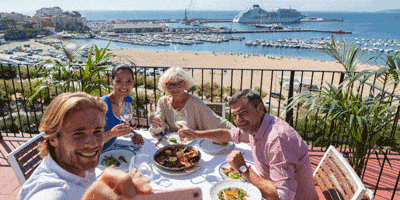Valeria Mangiarotti is the Marketing Manager at the Port Network Authority of the Sardinian Sea (ADSP), a position she has held since 2002. With over 20 years of experience in the maritime industry, she is a recognized expert in sustainability, environmental innovation, and cruise port development.
Valeria holds a law degree from the Catholic University of Milan in 1992 and a Master’s in Common Law from the London School of Economics. Since 2013, she has been responsible for environmental projects within ESPO and MedCruise, holding roles such as Director of Environmental Technical Solutions, Committee Member of “Ports as Hubs for a Sustainable Blue Economy”, and Senior Vice President of MedCruise. She is also a WISTA member and has served on the European Commission’s Expert Group on Sustainable Ports since 2019.
Since November 2022, Valeria is President of the “Cruise and Ferry Port Network” of ESPO, representing major European ports, cruises, and ferries. Additionally, she is a member of the Board of Bank Italy (Banca d’Italia) in Italy since 2013.
She has led Green Port initiatives, including studies on OPS (One Shore Power Supply) and LNG Supply, and has driven environmental projects for ESPO and MedCruise.

You have held executive positions in the cruise sector for over twenty years. How would you describe the evolution of environmental awareness within the cruise industry during that time?
Environmental awareness in cruise ports and cruise industry has changed significantly in recent years.
I remember that 15 years ago, there was talk of green solutions for ports, but all port stakeholders weren’t really aware that their behavior would make a difference.
Legislators’ attitudes have also changed significantly with Fit for 55 and the Green Deal, even the legislator, with this regulation wanted to send a clear signal that it is becoming very strict for all of us.
Is the OPS the right and ultimate solution? What is the alternative?
I think that we started to speak about OPS 15 years ago during some events of MedCruise.
At that time everybody was pessimistic about the future of OPS because this solution was thought to be futuristic.
Actually, we have the European directive that pushes the ports to adopt the green solution.
This solution will be mandatory for all ports: big ports and small ports.
I think that we have a lot of critical aspects regarding this solution and I want to underline some of these:
- The amount of energy when a cruise at berth spends 6 hours is more than 14 MW, which means that when you have 2-3 cruises in one day you need a big amount of green energy. How is it possible to have such a big amount of green energy in a port? How is it possible to have this infrastructure in a port without space or in a small port?
- Regarding the cost of energy, we have a big gap between northern Europe and southern Europe.
- As port authorities we cannot sell directly the energy to cruise companies because we are public companies. It will be necessary to make a public tender to identify the concessioner which can sell the energy.
- We need the standardization of energy plugs, which must be the same in all ports in the world.
- The space in the ports, the authorization to build the infrastructure of the OPS plant.
What impact has the implementation of the ECA (Emission Control Area) in the Mediterranean had on cruise ships? Does the region have the necessary infrastructure and logistics to face this challenge? How satisfied is MedCruise with the adoption of alternative fuels like LNG and methanol in the Mediterranean? What policies could support the logistics of new fuels in the region?
As of May 1, 2025, the Mediterranean Sea officially became an ECA (Emission Control Area) for sulfur oxide (SOx) and particulate matter emissions, as established by the International Maritime Organization (IMO).
This classification has significant impacts on all ships, including cruise ships operating in the region. Here is a summary of the main impacts on cruise ships:
Ships must now use fuels with a Sulphur content ≤ 0.10% (versus the global limit of 0.50%.
We will have some negative impacts:
- Increased operating costs, as low-sulfur fuel (such as MGO – Marine Gas Oil) is more expensive.
- Logistical adjustments, such as the supply of compliant fuels in Mediterranean ports.
However, cruise lines could choose to install scrubbers to continue using high-sulfur fuels while still meeting emissions limits.
In my opinion the Region cannot help the ports to develop these challenges the high initial investment costs and downtime during installation make this choice complex.
Furthermore, in some ports, the use of open-circuit scrubbers is prohibited, so it is not always an applicable solution.
About LNG, the Association believes that it is not a bridge solution but actually it could be a good solution for all ports.
The reason for this choice is the price of installation, which has to be reasonable for the Ports, the space , sometimes many ports don’t have empty areas to make an LNG infrastructure and last but not least, many cruise companies are building new cruises with LNG systems.

OPS infrastructure in the Mediterranean is being deployed more slowly than in other regions like the Baltic or ports in Florida. Only a few ports, such as Toulon, currently have such systems. However, more and more “cold ironing” initiatives and projects are emerging. How would you assess the current shore power infrastructure in Mediterranean homeports and transit ports?
There are many projects in Italy, Spain, and France, but they are still underway and not yet completed.
As part of MedCruise, Jamil Ouazzani, director of the Port of Tangier, and I developed a very interesting questionnaire that we distributed last year to all MedCruise ports regarding green projects in the Mediterranean.
We also involved the consulting firm SRM, which has conducted numerous studies in Europe with several northern ports, and the response was disconcerting: only 27% of ports are ready to provide electricity to cruise ships with cold ironing by 2025.
The other ports will only be ready with the OPS in 2030.
Even in my last panel during the general assembly in Cartagena, where I was a moderator, it emerged during the discussion that the ports of Valencia and Lisbon are not ready with the OPS, but they are ready with LNG.
The road is still long and if in 2030 the ports are not yet ready with the OPS the Legislature will have to adapt its laws to the real situation.
When will it be possible for a cruise ship to have OPS access at all the ports of call in the Western Mediterranean? When will the main historical homeports (Barcelona, Marseille, Civitavecchia, Genoa, etc.) have OPS facilities? Will Mediterranean ports be able to meet the 2030 deadline for offering this type of infrastructure?
If we consider the results of our survey (MedCruise) dedicated to cruise ports in the Mediterranean Sea, the answer has been that in 2030 98% of all members will be able to receive cruises with OPS but actually in the Mediterranean Sea few ports are ready for cruises .
These ports are Barcelona, Marseille, Civitavecchia the others ports have OPS but this system is not working yet.
The reason for the delay is the bureaucracy, the strict regulation to obtain permission to build the infrastructure and last but not least in Italy for example we need a protocol with coast guard to regulate the supply of OPS.
Many of the Mediterranean’s top cruise destinations are islands: Mallorca, Sardinia, Sicily, Mykonos, Santorini, Corfu, etc. Is island status compatible with OPS? Are their insular power grids capable of supporting OPS? Do they have sufficient renewable energy sources to supply a 5,000-passenger cruise ship?
Yes, is possible to have OPS on the islands, for example we are building in Sardinia in every port (we manage 8 ports) OPS for ferry and for cruises, but we cannot support with this energy 3 or 4 cruises per day.
For instance, in the port of Cagliari we are finishing the infrastructure of OPS of 14 MW (Megawatt) that means we’ll have to support just one cruise per day.
In Malta, the island the situation is currently very organized.
We visited the OPS infrastructure in the Valletta Port and they have a plant of energy of 60 MW. They have had 180 OPS connections in this period.
The MSC Europa stayed at berth in the Valletta port for transit and it consumed 60 MW per day. The energy price was acceptable and the port Authority was able to sell the energy directly to the cruise company.
They had a protocol between stakeholders, port authority and cruise company with PCS (port community system) to register the cruise that wanted to use OPS at berth.
In the Eastern Mediterranean, OPS infrastructure is practically nonexistent. What is the cause of this delay? When will the historical homeports in the region (Venice, Piraeus, Trieste, Ravenna, etc.) have OPS facilities, ideally by 2030?
For these ports we received answers to the survey and it was possible to understand that they are working.
Perhaps this delay could be caused by political problems.
You are a member of the Bank of Italy’s board. What can European and national financial institutions contribute to the funding of major environmental projects in MedCruise member ports?
I can say that, based on international research conducted by an independent body, the Bank of Italy has emerged as one of the «greenest» central banks in the G20 countries for its support to the development of more sustainable finance, the integration of sustainability criteria into its investment decisions, and initiatives to reduce the ecological footprint of its institutional activities.
Work is underway toward the net zero goal: reducing greenhouse gas emissions and the Bank’s environmental footprint.
Actually we cannot work in the shipping sector.
The most popular cruise terminal operation model in the Mediterranean is the concession model, with specialized operators like Global Ports or Cruise Terminals International (CTI) managing design, construction and operations. However, the ports granting these concessions often do not provide necessary infrastructure, such as electrical substations for OPS. That is that we have ships and cruise terminals ready for OPS use, but the ports lack adequate infrastructure. Do you believe ports are aware of this situation and are taking real steps to resolve it?
Yes, absolutely the ports are working in this direction, that is, building infrastructure for the port community and therefore also for the terminals.
There is a European Union project called “European Flagship Action for Cold Ironing in Ports” (EALING), which aims to accelerate the deployment of OPS solutions in EU ports and pursue key objectives. Has any MedCruise port participated in this project?
Yes we have some members of MedCruise involved in this project Valencia port foundation, Bulgarian ports and Greek ports.
As associations, ESPO is involved in the Ealing project, and we have provided technical and scientific contributions.
Medport and ECSA, EMSA DG move are also involved, but not Medcruise.
Royal Caribbean demonstrated its commitment to the Mediterranean with its acquisition of the Fiumicino-Isola Sacra Tourist Port concession to build a homeport near Rome capable of hosting its Oasis and Icon class ships. Major cruise lines are now building not just terminals but full ports in the Mediterranean. How do you assess this Royal Caribbean initiative? Do you believe other cruise companies will follow this model?
I don’t think this initiative will always be successful in all port areas.
Port authorities must be able to always monitor traffic and regulate services. Personally, I disagree with this policy.
Does MedCruise have a unified indicator system to monitor the evolution of cruise ship emissions in ports? Are there specific targets for reducing the environmental impact of cruise ships? When can we expect a “zero carbon footprint” cruise call in the Mediterranean?
It’s difficult to give an exact forecast for the exact moment we’ll have a zero-carbon emission port; we’re close.
Some ferry operators, like Grimaldi, have begun using battery-stored electric power while docked—something already common in the North Sea and Baltic. How does MedCruise view these initiatives? Can they be applied to cruise ships as well?
Yes, a cruise ship can theoretically run on batteries, but there are significant technical and practical limitations at the present time.
Batteries can power a ship, but there are challenges:
- Size and weight: The batteries needed to power a large cruise ship would be enormous, much larger than those used for electric cars or buses.
- Range: Cruise ships travel thousands of kilometers and are at sea for days or weeks. Current batteries do not offer sufficient range to completely replace combustion or hybrid engines.
- Charging times: Charging a battery of this capacity would require a very long time and very powerful port infrastructure.
I underline that technologies are advancing. Experiments are underway with:
Lighter and more powerful lithium batteries.
Hydrogen fuel cells.
Electric propulsion combined with renewable energy.
In addition to your role at MedCruise, you are a member of the Cruise and ferry port network of ESPO (European Sea Ports Organization), allowing you to share environmental improvement initiatives with your Northern European colleagues. In your opinion, which European port currently has the best infrastructure to minimize the environmental impact of its activities?
Many ports in the North have been working on the environment for years, but I believe that the most competitive port in terms of the environment is port of Hamburg.
It is the first European port to have provided OPS to a large cargo ship: the Vasco da Gama shut down its engines and was powered by electric cable during its stopover.
By the end of 2025, all major cruise and container terminals (Eurogate, Burchardkai, Altenwerder, Tollerort) will have fully operational land power connections.
One of the most pressing issues for the cruise industry in the Mediterranean is the perception of overcrowding—whether justified or not. What actions is the industry taking to correct or mitigate this perception? The taxes proposed by some cities like Barcelona or Venice for cruise passengers, or the ban that Nice wants to implement on ships of a certain size, are these truly effective solutions?
Countering cruise-related overtourism requires a mix of regulation, urban planning, and environmental sustainability. Port cities such as Venice, Barcelona, Dubrovnik, and Hamburg are already adopting it, limiting the number of ships and passengers. Here below there is an overview of solutions:
- Staggering arrivals
- Targeted environmental or tourism taxes
- Redistribution of tourist flows
- Environmental requirements and clean technologies
- Real-time flow monitoring
- Relocation of berth strategies.
I think that the most helpful solution for this phenomenon is the collaboration between port, city, and cruise lines.
It means the creation of agreements between local authorities and cruise lines to define shared goals: more sustainable flows, alternative routes, longer stops with local guided tours (greater economic value for the community).
Two of the last three MedCruise General Assemblies have been held in Spain, specifically in Tarragona and Cartagena. What is your opinion on Spanish cruise ports? In terms of environmental infrastructure, how would you assess their level of service: OPS, LNG bunkering, biofuel bunkering, MARPOL services, water supply, etc.?
I can say Spanish ports have been working in the environmental sector for years. They have received a lot of funding from the EU and they have used it very well and this has made the difference between them and the other Mediterranean ports.
Barcelona for example in my opinion, is the first cruise port in the Mediterranean sea regarding facilities and environmental solutions.












